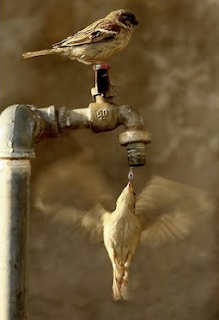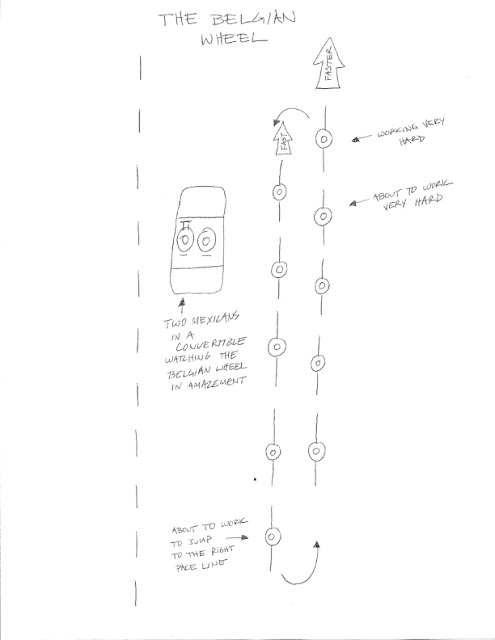 |
| Dr. Will is Dr. Evil. But he's really nice. |
 |
Then Dr. Will puts the face mask on you. There are other VO2 tests which don't require a mask, but do require taking blood. Regarding the blood-draw method, Dr. Will said, "The inflection point is harder to find." I didn't slow the fast-talking doctor down to ask what he meant (or to insist on a blood draw), but I think you'll see what he means when we look at my results.
 |
| Darth Vader's mask is also hard to breath in. But for Darth Junior and a VO2 max test... you can't NOT ride with the mask. |
I had mentally prepared to embrace the pain cave all week, but failure is never an easy place to go, even if we do it several times per week in Spinning. I lasted about 15 minutes before I tapped out. Maybe I could have gone more, but in addition to the effort being extremely hard, having the mask restrict my breathing made me feel claustrophobic and panicky-- a bit too far beyond my "comfort zone" of normal excruciating pain.
Dr. Will gave me a two page print-out of a table of numbers, which is difficult to make sense of. But once I put them in graphical form, it's a bit more intuitive to see what's going on and it seems to match what I saw Dr. Will looking at on his computer monitor.
RESULTS
The red line is where I blew up and terminated the test. The intersection of the red line and purple line (VO2/kg) is the ultimate goal of what we are looking for-- VO2 MAX. In other words, what is the largest volume of oxygen my body can breathe in and make use of to burn its fuel in my cells. It was 68.7 ml/kg/min (or 4.78 L/min). At this point of maximum effort, my cycling heart rate is 189 beats per minute. Note that your maximum heart rate is not usually equivalent across sports and it's a physiological feature that many experts say cannot be changed. Your max is your max. It's not bad. It's not good. It just is. But my VO2 max value of 68.7 ml/kg/min definitely can be changed. It's my goal to bump it up.
OTHER STUFF
As you can see, my heart rate is indicated in orange and increases as Dr. Will adds resistance and as time passes (horizontal axis). The green line has something to do with my "ventilation" rate. It stays pretty much parallel with my heart rate until it reaches the aqua line-- my "Threshold". At this point, ventilation and heart rate de-couple. This is what Dr. Will meant by "inflection point". It is the super-critical point, called The Lactate Threshold (or Anaerobic Threshold), beyond which lactate is produced in the muscles faster than it can be removed. This is where your exercise activity crosses over from being primarily aerobic to primarily anaerobic. So, 171 beats per minute is my threshold heart rate. This completely agrees with my suspicion from low-tech DIY thresholds tests at Spinning class. It is also the heart rate I tend to average for a 40k time trial. Cycling guru, Joe Friel, refers to this pace as your Critical Power 60 (CR60)-- as in, this is the maximum power you can sustain for 60 minutes. He also calls it Functional Threshold Power (FTP).
Dr. Will said the highest VO2 max he had ever tested on someone was 79-80 ml/kg/min. He also said that a sedentary college aged male measures at about 35 ml/kg/min. Cross country skiers are famous for having VO2 max's in the 90s ml/kg/min! But what does it all mean? How can I get faster?
The most important outcome for me for this experiment was to find my threshold. This has far more relevance to my race pace than VO2 max. In fact, maximum power is not the determining factor of race victories; rather, your efficiency at sub-max levels is more predictive of endurance race success.
The secret to improving your race pace is to train just below, at, around, about your lactate threshold. With smarter training through the season, bigger efforts should be perceived as more manageable and sustainable. At this point in the spring season, 171 bpm is 89% of my max heart rate. As the season progresses, I might be able to race for one hour at 95% of my max heart rate.
FYI
While searching some cycling forums, I found that world class pro rider Ivan Basso achieved the following results on his VO2 Max test:
VO2 Max Test
VO2 5.760 L/min
VCO2 6.458 L/min
VO2/kg 83.5 mL/kg/min
VCO2/kg 93.6 mL/kg/min
VE(BTPS) 215.8 L/min
Max HR: 196
Max Power: 490 Watts
Max Power to weight ratio: 7.1 Watt/kg
Ananerobic Threshold
VO2 4.680 L/min
VCO2 4.824 L/min
VO2/kg 67.8 mL/kg/min
VCO2/kg 69.9 mL/kg/min
VE(BTPS) 129.1 L/min
AT HR: 175
AT Power: 380 Watts
FTP power to weight ratio: 5.5 Watt/kg
These are the numbers it takes to win the Giro d'Italia!
 |
| Real men wear pink (in Italy especially). |























